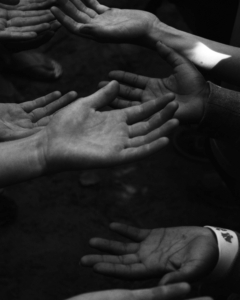If you are currently sitting at your laptop or reading this on your phone, then you are likely asking yourself the following questions: “What is my attachment style?”, “How does my attachment style show up in the world?”, “What are the different attachment styles?”, or “Why is attachment important?” If that’s you, welcome.
In the field of psychology, “” is widely understood as being “the emotional-relational bond created between a parent and child during the first few years of the child’s life.” This bond is characterized by and observed through proximity-seeking behavior from the child toward the parent, and from the parent toward the child.
An attachment is formed via the repeated cycles of the child seeking connection with his or her parent, and the parent’s ability to respond to the child’s emotional needs appropriately. As these cycles are repeated, the behavior becomes ingrained as the child’s way of understanding how emotional connections and relationships happen in the world.
 Through the lens of attachment, the ultimate goal of the child is to establish and maintain an emotional connection with his or her parent. Emotional connection for the child means a felt sense of safety in the relationship, an understanding that emotional needs will get met, and an understanding that if the relationship is ruptured in any way repair is possible. Attachment is the primary way that a child connects with his or her parents.
Through the lens of attachment, the ultimate goal of the child is to establish and maintain an emotional connection with his or her parent. Emotional connection for the child means a felt sense of safety in the relationship, an understanding that emotional needs will get met, and an understanding that if the relationship is ruptured in any way repair is possible. Attachment is the primary way that a child connects with his or her parents.
This connection is not simply a want or desire, but a biological need to survive. Yes, we are biologically driven to attach to others to survive. We cannot escape it. When we perceive threat or danger, we are hard-wired to seek protection from – and maintain proximity to – someone who will be there for us, and who truly knows us.
It is this connection that forms your brain more than any other relationship. More specifically, attachment relationships shape your ability to regulate emotions (calm yourself), ability to be aware of your emotions, ability to rebound from stress, harm, or tragedy, and style of relating to others throughout your life.
The reality of attachment is that these emotional-relational interactions with your parents create a template through which you relate to others in your life. These templates are known as “Attachment Styles.” Others may use the term “Styles of Relating” to refer to the same concept. It is important to remember that these templates are how we have learned to attain and maintain emotional-relational connections with others.
Different attachment styles are formed in us early in life and are marked by certain behavioral traits that we carry with us into adulthood. Four different attachment styles are widely recognized: Secure Attachment, Ambivalent Attachment, Avoidant Attachment, and Disorganized Attachment.
Secure attachment
Let’s start with Secure Attachment. Counselor and podcaster Adam Young summarizes secure attachment in this way, “If your parents were attuned to you, responsive to your needs, engaged with your heart, able to regulate your arousal, strong enough to handle your negative emotions, and willing to repair failures, then the result was a secure attachment.”
With this in mind, Secure Attachment in childhood can be understood and characterized in the following ways:
- It shows itself as a more balanced behavior. This means that the child is flexibly able to switch from asking their caregiver for affection and attention to occupying their own time with toys.
- A securely attached child can express his or her emotional experience to their parents.
- The child shows little to no separation anxiety or emotional distress when the parent leaves yet seeks their proximity upon return. They find comfort in being close to their caregiver.
It is important to recognize that your attachment style is directly related to how your parents engaged with you. Your parents have an important role in the formation of your attachment style. This is true in the formation of all the different attachment styles. The parents of a securely attached child can be characterized in the following ways:
- Parents of securely attached children display the wherewithal to engage with another person and their own thoughts, feelings, memories, etc. simultaneously.
- They can flexibly shift back and forth between their internal and external world.
- They show stability in being able to think and reflect on a memory or experience.
- Their emotional range is wide, and they can express their feelings as well as regulate them when faced with something distressing.
 In adulthood, the securely attached person can clearly and effectively communicate their needs, wants, and desires. They are typically comfortable and relaxed while both being alone or in social settings and can seek out support when it is needed. They have healthy boundaries in close relationships.
In adulthood, the securely attached person can clearly and effectively communicate their needs, wants, and desires. They are typically comfortable and relaxed while both being alone or in social settings and can seek out support when it is needed. They have healthy boundaries in close relationships.
This individual has a more well-rounded, stable, and balanced internal and external world. This is in opposition to the other attachment styles where the internal world is often unstable, dysregulated, and without a healthy relational structure. Both the adult and child with secure attachment is, in some regard, the gold standard for how one interacts relationally in the world.
Insecure attachment
Ambivalent, Avoidant, and Disorganized attachment styles fall into the category of Insecure Attachment. With these attachment styles, there is a common experiential thread of abandonment, betrayal, or powerlessness.
Ambivalent attachment
Let’s start with Ambivalent Attachment. Ambivalent Attachment has also been referred to as Anxious Attachment and Preoccupied Attachment. The child who develops an ambivalent attachment style can be described in the following ways:
- The child is stuck between moving toward wanting intimacy and affection from their parent or caregiver, while equally, pushing away from intimacy and affection.
- The child is constantly unsure of how their parent is going to respond to them.
- The child becomes inwardly frantic as he or she struggles to find relief from their anxiety and uncertainty. This eventually develops into a state of emotional terror.
- Ambivalently attached children must adapt to their parents’ mental and emotional state to truly capture their attention.
- The relationship between child and parent becomes an endless emotional guessing game.
- The relationship becomes primarily one in which the child is responding to the parent’s own emotional needs instead of getting his or her needs met by their parent.
The parent of an ambivalently attached child can be described as inconsistent, meaning, sometimes mom is attuned and responsive to the child’s needs, but at other times she is too caught up in her own emotional needs and moods to focus on meeting the child’s needs. When the child becomes distressed, their caregiver may or may not provide soothing and comfort. It all depends on what is going on for the caregiver at that particular moment.
In adulthood, the ambivalently attached person can display their anxiety in a number of different ways. However, the defining characteristic is a strong fear of abandonment. Here are some ways this gets translated into behavior in adulthood:
- It can be expressed as being vigilant, more sensitive, or being hyper-aware of the emotions of others.
- Fear of abandonment is often activated, or triggered, by people who express instability and uncertainty in their own emotional state.
- This person will find ways to adapt their emotional states, needs, wants, etc. to tend to the needs of others so that the relationship may continue to function.
- They are plagued by a deep-seated fear that they are going to be rejected or abandoned, making it difficult to trust anyone.
- The person feels like they are too needy and that they do not deserve to be loved in the way that they want.
- They suffer from self-criticism, insecurity, and a sense that something is wrong with them.
- Rely heavily on others to validate their self-worth, often seeking approval and reassurance from others.
- Assume the role of the “pursuer” in a relationship.
Avoidant attachment
With Avoidant Attachment, another name used to describe the same concept is Dismissive Attachment. In children, avoidant attachment looks as one would picture it: being avoidant, dismissive, or appearing not to need close emotional or physical contact with a parent or caregiver. Here are some other defining characteristics:
- The avoidantly attached child seems to lack flexibility and resourcefulness.
- Avoidantly attached children can greatly restrict their emotional range of expression. Meaning, that the child has learned to not display their emotions, but they are felt physiologically all the same.
- The child will often move away from or reject care, intimacy, or affection from their caregiver when approached by them. This child appears unfazed when separated from their caregiver.
- The child reasons that it is easier to try to regulate his or her anxiety than to seek comfort from their unavailable or unresponsive caregiver.
- The child learns that relying upon others to meet his needs is fruitless.
- The core narrative becomes “I am alone and on my own. I don’t need you to be there for me. I’m fine whatever you do.”
- The child becomes self-reliant, begins to view himself/herself as strong and independent, adapts to their environment by avoiding closeness and emotional connection with a caregiver, tries to numb himself or herself to desire for any emotional connection, and eventually becomes disconnected from desire and emotion due to the pain of those needs consistently not being met.
The parent or caregiver of an avoidantly attached child can be described as follows:
- They exhibit a pattern of regularly dismissing or minimizing the importance of attachment relationships.
- They are often unavailable, dismissive, or rejecting.
- The caregiver does not provide sufficient comfort, care, and connection.
- When the child tries to communicate his or her distress, their attempts have little to no effect on the parent.
In essence, the parent of an avoidantly attached child is equally avoidant to their own emotional needs. This translates into them being unable to tend to their child’s emotional needs, which likely means that they do not have a strong inner emotional life. What gets communicated to the child is that their needs or wants do not matter to the caregiver.
In adulthood, someone who has this particular attachment style will often have a flattened emotional experience of his or her life, with flattened meaning diminished, restricted, and greatly minimized. They are equally unable to express their emotions and their emotional needs. Other descriptors include:
- Being unable to sit with their own emotional experience.
- Often projecting their emotions into or onto others, including their ignored needs, vulnerability, and anger.
- Often presenting as highly self-sufficient, independent, strong, confident, and in control.
- In relationships, they will often pull away and distance themselves (physically, mentally, emotionally) if they sense someone getting “too close.”
- Their internal world is one marked by isolation which is further shown in their external behavior of keeping others at an arm’s length.
- Will focus on the cerebral and analytical, so that they can avoid the pain and longing of missed emotional connections with others.
- Idealize their parents (to avoid connecting with how bad it really was).
- Believe that family life had little to no effect on how they developed.
- Insist that the past has little to no influence on their present life.
Disorganized attachment
 Finally, we come to Disorganized Attachment. Another name for this attachment style is Disoriented Attachment. This particular attachment style presents itself as a mixture of both the ambivalent and avoidant attachment styles.
Finally, we come to Disorganized Attachment. Another name for this attachment style is Disoriented Attachment. This particular attachment style presents itself as a mixture of both the ambivalent and avoidant attachment styles.
In children, a disorganized or disoriented attachment style is almost like an anti-attachment. The child has a longing to be attached to his/her parents but is also equally afraid of them. In other words, the person who is supposed to be their main source of safety is also their main source of harm.
There is a sense of dissociation due to this fear the child feels in tandem with the feeling that they cannot do anything about it. In other words, they’re stuck, helpless, or powerless. If you can picture a deer standing still in a car’s headlights as the car approaches it, then you get the point.
The parents of children who express this attachment style have been found to carry unprocessed or unresolved trauma. The trauma itself is not the issue, but rather, the lack of resolution of the traumatic event.
Parents of disorganized children exhibit lapses in their reasoning as well as reality testing when it comes to specific details about an event. Denial becomes the primary mode of defense against unresolved trauma. In other words, the parent will deny that the traumatic event has had any lasting impact on them, or that it even happened. They have “moved on.”
Adults with this attachment style have a feeling of being unstable and unsettled internally. This is because they never learned how to regulate, and their parents never gave them the space to regulate. This is because they themselves were internally unstable. Internally they are often stuck, wanting affection while backing away from it at the same time. Ultimately there is fear of receiving care even though it is the thing they need the most.
Next steps
Ok, now take a deep breath. You have just encountered a lot of information all at once. Some of it may have been new, exciting, or possibly disruptive. That can be overwhelming. As you have been reading, there may have been some things that resonated with you.
 There may have been certain things that rubbed you the wrong way. Pay attention to those things. It could be your heart signaling to you that something needs to be explored, or that there is healing needed in a particular area of your emotional-relational life.
There may have been certain things that rubbed you the wrong way. Pay attention to those things. It could be your heart signaling to you that something needs to be explored, or that there is healing needed in a particular area of your emotional-relational life.
If anything that you read resonated with you and you sense the need to explore further, seeing a counselor is a great place to start. In counseling, it can be really valuable to discuss our emotional and relational experiences, especially the experiences we have with the people closest to us.
As a counselor, I find joy in helping people make sense of their experiences and all of the emotions that come with them. I believe that understanding our different attachment styles can significantly help us understand ourselves and the people around us better. It can reduce shame and guilt while creating room for greater compassion in our lives.
As you are looking to take the next steps, contact us at Seattle Christian Counseling to see if there is a care provider in your area. There is a team of wonderful people waiting to help guide you through the process of starting counseling and set you up with a counselor that’s right for you.
“Sitting on a Bench”, Courtesy of Matthew Bennett, Unsplash.com, CC0 License; “Couple Walking”, Courtesy of charlie, Unsplash.com, CC0 License; “Touch the Water”, Courtesy of Nick Moore, Unsplash.com, CC0 License; “Helping Hands”, Courtesy of McKenna Phillips, Unsplash.com, CC0 License










